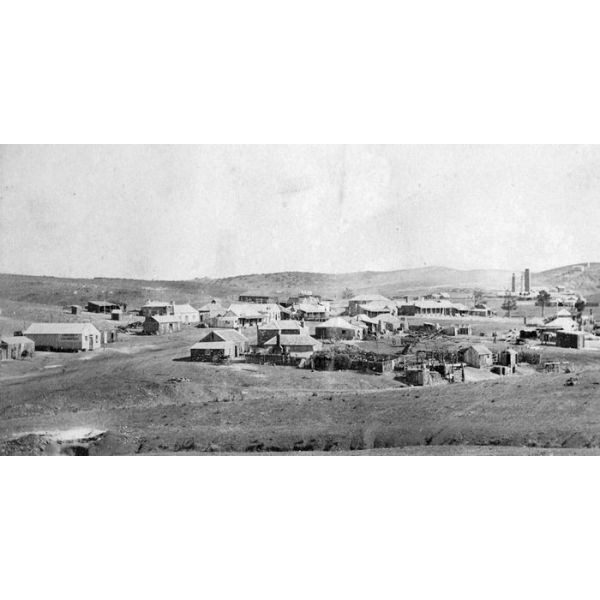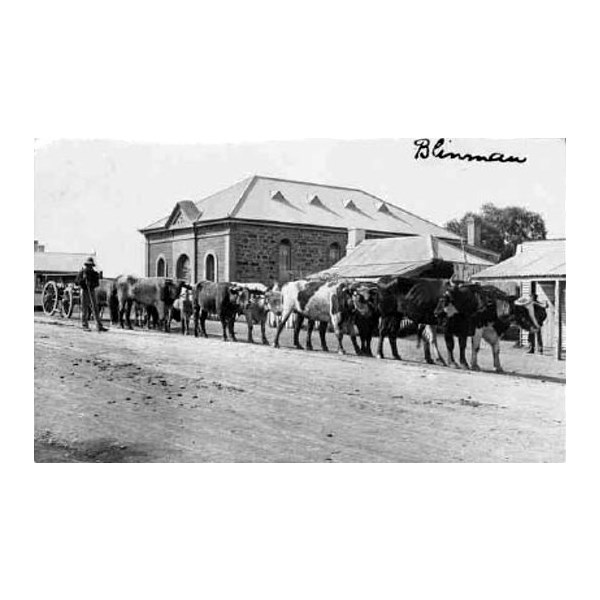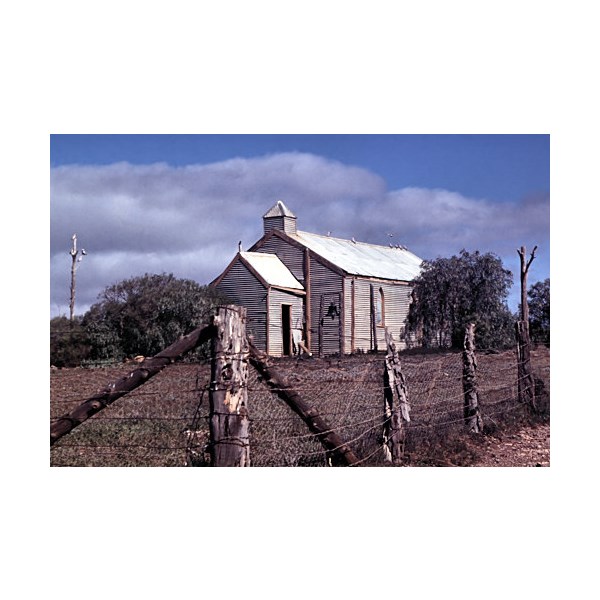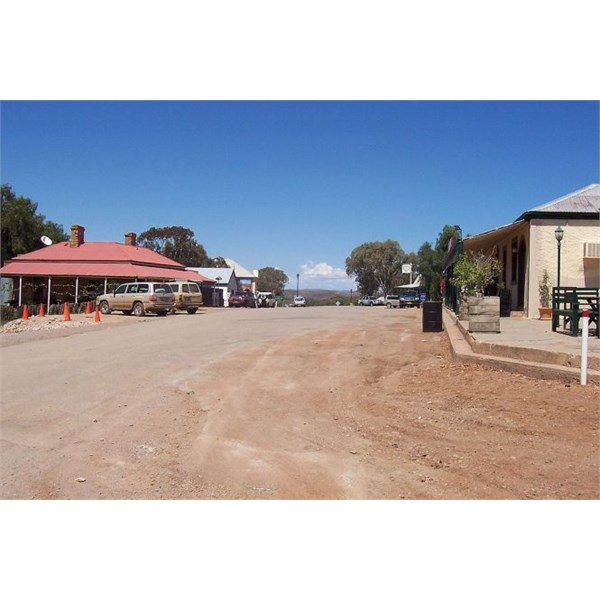Blinman is a town deep in the
Flinders Ranges, in the mid north of South Australia. It is very small but has the claim of being the highest surveyed town in South Australia. It serves as a base for large acre pastoralists and tourism. The town is just north of the
Flinders Ranges National Park, is 60 kilometres north of
Wilpena Pound and 485 km north of
Adelaide.
On a hot December day in 1859 Robert
Blinman, a shepherd employed at H.C. Swan's Angorichina station observed a great mineral outcrop on top of a
hill, about thirty metres above a creek. To him it looked not only big, but also promising enough to gamble a few weeks' wages on. He needed at least $10 to make a mineral application to secure the outcrop and the area around it.
Blinman's application was approved on 9 February 1860 and surveyed on 10 May 1860.

Robert Blinman, his wife Hannah, and a son and a daughter

Blinman 1880

Bullocks haul a wagon through Blinman about 1904
Like most other shepherds, Robert
Blinman would not have had too many $10 notes to gamble with, but he was able to convince others of the richness of the copper outcrop. When the lease was issued on 1 January 1861 it was made out in the names of Robert
Blinman, Alfred Frost, Joe Mole and Henry
Alford. They all contributed to the $80 needed for the first year's rent. Their lease was one of 116 others taken out that year in South Australia and eventually became the largest and most productive copper
mine in the
Flinders Ranges.
As was usually the case, no sooner had
Blinman been granted his mineral application, than numerous other applications were made for sections around
Blinman's original lease. As early as 25 February 1862 Robert
Blinman and the other leaseholders sold their
mine, known as the Wheal
Blinman, to the Yudanamutana Copper Mining Company of South Australia, for $12,000. This English company hired Captain Thomas Anthony and work was started in earnest.

Blinman Mine 1903

'Blinman Mine'

Bullocks haul a wagon through Blinman about 1904
Work at the
mine was started by stoping away the top of the deposit on the
hill, which was a 'splendid' ore body, nearly two and a half metres wide. By the end of 1862 five shafts had been sunk into the deposit, the main shaft reaching a depth of eighteen metres. More that six hundred tons of ore were recovered, four hundred of which were estimated to yield about forty percent copper.
Mining the copper ore, although certainly not a simple process, was at times the easiest part of the total production process. One of the most troublesome parts was transporting the ore to the smelters. With no smelters available at the
mine yet, the copper ore was taken along a worse than torturous track via Wilpena and
Arkaba stations to
Port Augusta. This route was later changed and went through
Brachina Gorge.
This land belonged to the Adnyamathanha tribe, of Indigenous Australians prior to Europeans. They were stone age hunter-gatherers and inhabited much of the area (including
Wilpena Pound to the south and other areas to the north). One of their unique customs was burn offs to promote plant growth in the future seasons.
The first
European settlement around the current
Blinman, was firstly of Angorichina Station. This land was taken up for sheep farming in the 1850s. A shepherd employed by the station, Robert
Blinman, discovered a copper outcrop on a hot December day in 1859.
Blinman gambled some of his money on the presence of more underground copper and received a mineral application in 1860. On 1 January 1861,
Blinman and three friends, Alfred Frost, Joe Mole and Henry Alfred, received the lease for the land that became
Blinman
Another form of transport in Blinman 1920

Blinman church 1961

Blinman main street
Mining was successful in the first year and the
mine became known as Wheal
Blinman. The original four leaseholders sold their
mine in February 1862, for about 150 times the purchase price. The new owners were the Yudnamutana Copper Mining Company of South Australia, who also owned a rich deposit north of
Blinman. The
mine was very successful during the 1860s and the site became permanent, with buildings being constructed and more miners moving to the area, some from the
Burra mine. The hardest problems at the time were the transport of Ore and the finding of water. Over the next 20 years, railways were developed and wells were sunk at regular intervals making life easier for all.
Family life was hard in the early days. Both water and firewood had to be brought from long distances from the
mine. This job was left to the women and their elder children while the men were working. Many pregnancies failed in the early years and there were several deaths reported from inflammation of the lungs. With the original tent settlement being very close to the
mine, it was very hard to escape the fine dust generated. A hotel and
post office were first opened in
Blinman in 1863. In 1864, a government surveyor laid out 162 allotments about three km from the
mine. This was named
Blinman. The
population was about 1,500 by 1868 and the first school opened that year. Decent shops in the main street developed in 1869. The striking of regular water in the
mine the same year secured a regular
water supply for the town.
Mining continued until 1918 when the ore ran out. The busiest time for the
mine was 1913-1918 with a town
population of 2,000. The total ore removed was about 10,000 tonnes.

Former Blinman School ...became a cafe
.